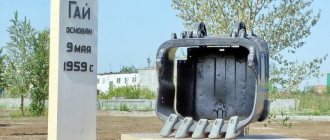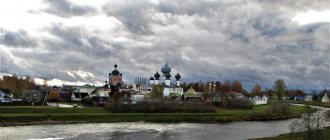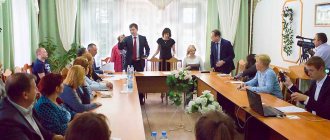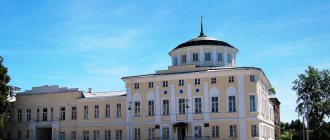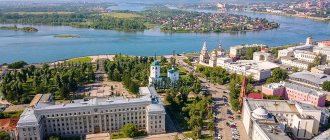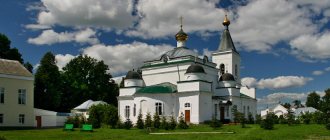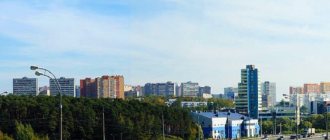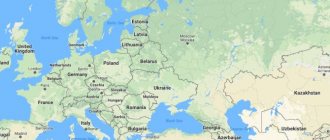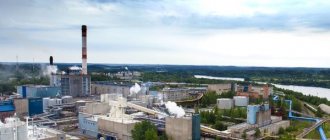The history of the emergence and development of the city of Kirov
The location of modern Kirov is the southern slopes of the Smolensk-Moscow Upland. The Bolva River flows nearby. The Pesochnya River flows into it. The city has 2 reservoirs - the Upper, formed after the construction of the dam, and the Lower, located within the city.
Archaeological finds prove the presence of human settlements along the banks of the Bolva River back in the Stone Age and settlements in the ancient and Middle Ages. And now there are mounds telling about the battles of the 13th-14th centuries.
Ivan III in his spiritual letter mentions the village of Fominichi. In various chronicles there are records of wooden churches of the 16th century, and of a monastery in Berezhki, operating in the 17th century.
The village of Pesochnya appeared in 1745. The name is associated with the nature of the soil and the river. Then the Zolotarev merchants created a metallurgical plant that produced cast iron dishes, oven castings, and nails. Four years later, ownership of the enterprise passes to the great-grandfather of Natalya Goncharova (Pushkin’s wife) - Afanasy Goncharov. He and his heirs owned it for 90 years. During this time, the following appeared in the village:
- Church of the Nativity of the Blessed Virgin Mary made of stone;
- plant management, consisting of 2 floors;
- house at the estate;
- new factory buildings - sawmill, nail factory.
In 1839, the Pesochensky factories were acquired by Ivan Maltsov. The Upper Plant continued to produce kitchen and stove castings. And the Nizhne Pesochensky Hammer Plant was repurposed for the production of earthenware dishes. Local white refractory clay was used to make it.
This is what the faience factory looked like
Sergei Ivanovich Maltsov, the owner of industrial enterprises, played a huge role in the history of Russia. His many actions surprised contemporaries and historians:
- During the years of serfdom, corporal punishment was not used against its peasants.
- Houses were built for them at the expense of the owner.
- In hard jobs, people worked 8 hours a day. This has never happened in Russia before.
- Maltsov financed the opening of educational institutions and hospitals.
His contribution to the creation and development of railways and railway engineering in Russia is enormous. On trips to Europe, he was interested in new products in this industry. He then met with Emperor Nicholas I and presented his projects to him. He proposed to involve exiles in the construction of railways. He created several railway projects. In addition, he put forward the idea of creating rail rolling plants in Russia. Then, one of his factories begins to produce steam locomotives and carriages.
The middle of the 19th century was the time of construction of stone houses on Bolshaya Pesochnya Street. Currently it has been renamed Proletarskaya. This street connected two factories and the villages created by them. But the division of the city into Upper and Lower exists even now.
A narrow-gauge railway appeared in Pesochnya in 1881. It connected the village with Bryansk and Dyatkovo. Not only freight trains moved along this road, but also passenger trains. Passengers were transported along it until 1932, when the Fayansovaya station was opened. Later the road was destroyed. A very small section has been preserved for the transportation of goods from the Kirov plant to Fayansovaya station.
Next to the iron foundry there was a station (wooden building), a room for steam locomotives and an extension for the locomotive crews to rest. With Maltsov's participation, an enamel factory was built.
Since 1936, the village of Pesochnya was given the status of a city and given the name Kirov. During the Great Patriotic War, the city's industry suffered greatly - some enterprises were evacuated to the rear, and the remaining factories suffered enormous damage. It was necessary to rebuild damaged residential buildings, restore communication lines for power, water and heat. The city is divided into 4 microdistricts:
- Upper;
- Lower;
- Earthenware;
- Zhilino.
A workers' settlement near the Fayansovaya railway station served as the basis for the creation of a microdistrict with the same name. It is separated from the city center by the Bolva River. A significant part of industrial and transport enterprises are located in the northern part of the microdistrict.
There is no industrial production in the Zhilino residential area. This is a picturesque area with one-story buildings and natural landscaping. In terms of economic benefits, the city is not in a particularly advantageous location, since there is no direct connection with Kaluga and Moscow. So, for example, from Moscow Kirov is located at a distance of 250 km in a straight line, by highway - 285 km, and by railway - 333-383 km. But through the main railway St. Petersburg - Donbass the city has connections with Bryansk, Murmansk, cities of Southern Ukraine and Crimea.
The connection between the city and the lives of famous people
The lives of many famous people are closely intertwined with Kirov:
- In 1966, Yuri Gagarin visited it.
- Maxim Goretsky, a Belarusian scientist and writer, lived there for the last 2 years of his life. He worked as a teacher of Russian language and literature at secondary school 1.
- The first president of the Chechen Republic, Dzhokhar Dudayev, had his first meeting with his future wife while serving in the Shaikovka garrison.
- Konstantin Bushuev, a well-known scientist in the rocket science industry, graduated from the Pesochensky Industrial College.
Natives of this area are Demichev (former Minister of Culture), Chistyakov (children's writer), Ovsyankin (sculptor), Eremenkov (participant in the First World War, the Civil War and the Great Patriotic War).
Map
| Kirov: maps |
Kirov: photo from space (Google Maps) Kirov: photo from space (Microsoft Virtual Earth)
| Kirov. Nearest cities. Distances in km. on the map (in brackets along roads) + direction. Using the hyperlink in the distance , you can get the route (information courtesy of the AutoTransInfo website) | |||
| 1 | Betliza | 24 (35) | Z |
| 2 | Lyudinovo | 26 (30) | YU |
| 3 | Baryatino | 28 (35) | NE |
| 4 | Spas-Demensk | 40 (49) | NW |
| 5 | Ivot (Bryansk region) | 45 (76) | YU |
| 6 | Zhizdra | 46 (56) | SE |
| 7 | Dyatkovo | 53 (64) | YU |
| 8 | Duminichi | 55 (102) | IN |
| 9 | Rognedino (Bryansk region) | 58 (147) | SW |
| 10 | Mosalsk | 62 (73) | NE |
| 11 | Lyubohna (Bryansk region) | 64 (74) | YU |
| 12 | Desnogorsk | 66 (104) | Z |
| 13 | Dubrovka (Bryansk region) | 67 (161) | SW |
| 14 | Sukhinichi | 68 (120) | IN |
| 15 | Meshchovsk | 69 (104) | IN |
| 16 | Fokino | 70 (91) | YU |
| 17 | Zhukovka | 71 (124) | SW |
| 18 | Ugra (Smolensk region) | 76 (106) | WITH |
| 19 | Rzhanitsa (Bryansk region) | 76 (143) | YU |
| 20 | Seltso | 80 (145) | YU |
| 21 | Khvastovichi | 86 (226) | SE |
| 22 | Glinishchevo (Bryansk region) | 88 () | YU |
| 23 | Yelnya | 90 (249) | NW |
| 24 | Ulyanovo | 91 (200) | SE |
| 25 | Bryansk | 92 (109) | YU |
| 26 | Bolshoye Polpino (Bryansk region) | 94 () | YU |
| 27 | Yukhnov | 95 (120) | NE |
| 28 | Roslavl | 95 (131) | Z |
| 29 | Kozelsk | 96 (152) | IN |
| 30 | Suponevo (Bryansk region) | 97 () | YU |
a brief description of
Located on the river. Bolva (tributary of the Desna), railway Fayansovaya station, 160 km southwest of Kaluga.
Territory (sq. km): 36
Information about the city of Kirov on the Russian Wikipedia site
Historical sketch
It arose in 1745 as the village of Pesochnya at the metal Pesochensky Plant. Named after the nature of the soil.
At the end of the 19th century. There were factories in operation: iron-smelting and earthenware factories of the Maltsovsky (named after the owner I.A. Maltsov) factory district, and later the Maltsovsky commercial and industrial partnership. Earthenware was made from local white refractory clay and exported to Rostov-on-Don, Nizhny Novgorod, and Kyiv.
The workers' settlement of Pesochnya since November 9, 1925. The city of Kirov since 1936, named in honor of S.M. Kirov (1886-1934).
During the Great Patriotic War of 1941-45, it was occupied by Nazi troops on October 4, 1941. Liberated on January 11, 1942 by troops of the Western Front during the Rzhev-Vyazma operation.
The city includes the working settlement of Fayansovy (PGT since 1940; 7.0 thousand inhabitants, 1959). [Specify when].
Economy
JSC "Kirov Plant" (production of bathtubs, boilers) and "Kirov Stroyfarfor" (sanitary ceramic products, facing tiles). Garment factory.
Food industry enterprises: meat processing plant, dairy plant, bakery. Factory of reinforced concrete products.
In the Kirov region: dairy and beef cattle breeding, pig farming, poultry farming.
Deposits of sand, clay, sand and gravel mixtures.
Main enterprises
MECHANICAL ENGINEERING AND METAL WORKING
OJSC "Kirov Plant"
249420, Kaluga region, Kirov district, Kirov, sq.
Zavodskaya, 2 Offers:
cast iron bathtubs, locomotive brake pads, rolling stock brake pads
BUILDING CERAMICS INDUSTRY
CJSC "Kirovsky Stroyfarfor"
249420, Kaluga region, Kirovsky district, Kirov, st.
Gorkogo, 46 Offers:
Products from building faience and building porcelain, from fireclay masses: bathtubs, floor urinals
GARMENT INDUSTRY
JSC "Kirov Sewing Man"
249420, Kaluga region, Kirov district, Kirov, st.
Lenina, 7 Offers:
sewing products, clothing
BAKERY INDUSTRY
Municipal Unitary Enterprise "Kirovsky Bread Factory"
249420, Kaluga region, Kirovsky district, Kirov, st.
Zhemakina, 1 Offers:
Bakery products
Museums, galleries, exhibition halls
Kirov City Museum of History and Local Lore 249420, Kaluga region, Kirov district, Kirov, st. Lenina, 1 Phone(s): (48456) 2-0659 Website: https://kirmuseum.ucoz.ru/
Architecture, sights
Churches of the Nativity of the Virgin Mary (late 18th century) and Alexander Nevsky (1893).
Near the villages of Prudki, Vyseltsy, Nagornoye and others are the burial mounds of the Vyatichi and Krivichi (10th-12th centuries).
| Population by year (thousands of inhabitants) | |||||||
| 1897 | 4.3 | 1992 | 37.2 | 2007 | 38.8 | 2016 | 30.9 |
| 1931 | 9.0 | 1996 | 40.7 | 2008 | 38.7 | 2017 | 30.8 |
| 1939 | 15.3 | 1998 | 40.6 | 2010 | 38.6 | 2018 | 30.5 |
| 1959 | 16.6 | 2000 | 40.8 | 2011 | 31.9 | 2019 | 30.3 |
| 1967 | 26 | 2001 | 40.7 | 2012 | 31.6 | 2020 | 29.9 |
| 1970 | 29.4 | 2003 | 38.9 | 2013 | 31.4 | 2021 | 29.9 |
| 1979 | 33.5 | 2005 | 38.9 | 2014 | 31.2 | ||
| 1989 | 36.0 | 2006 | 38.9 | 2015 | 31.0 | ||
Upper Lake
Locals are very proud of their Lake Superior. Although it would be more correct to call it a reservoir. It was formed after the creation of a dam on the Pesochnya River. Its area is 215 hectares.
The lake is a favorite place for locals, especially in the summer.
It is suitable for swimming. Its bottom is sandy. Artists are attracted to this place by its beautiful landscapes.
Alexander Zoryukov created more than one painting near the shores of the lake. One of them is “Bay on Lake Superior”
Unfortunately, the mansion that belonged to the Goncharov family, which stood on the shore of the lake, has not been preserved.
Monument to the lumberjack foreman
If you want an interesting photo, take it near this statue. Its uniqueness will attract the attention of your friends.
Monument to a lumberjack painted as a foreman
It turns out that the role of this sculpture is to advertise a house-building plant. It serves as a pointer to it. Initially, it looked quite simple - a figure made of gray concrete, somewhat reminiscent of a woodcutter from the book “The Wizard of Oz” or a robot. Later the monument was modified. The artists of the Rudnev brothers had an idea - to transform the standing figure into a foreman. Soon he had a name - Felix.
Driving into Kirov from Moscow, you will see this statue. It is installed on Stepan Razin Street in front of the dam.
Smolovsky cult stone
The Smolovka forest area attracts tourists with its huge stone temple. A temple is a sanctuary, a place where services were held and all kinds of rituals were performed.
According to an ancient legend, human sacrifices were performed at this stone.
It is all painted with ancient signs - runes. A significant part of them is poorly visible. There is debate about the origin of these signs:
- Early Christian myths explain their origin as “the traces of the Virgin Mary.”
- Other assumptions are that they are the first letters of the names of people who became victims of rituals.
In order to study them, you need to clean the overgrown covering of the block. There is more than one such “special stone” in the Kaluga region, but the boulder from Smolovka is the largest of them. Next to him lay another stone, smaller in size. But in the 50s he was taken to an unknown direction. This event is attributed to the fight against superstitions.
You can get to the stone by walking along the alley from Academician Frolov Street to Chkalov Street.
Private advertisements in Kirov, Kaluga region and Russia
To add an advert
Kaluga
Repair of servo motors servo motors encoder resolver servo ...
Kaluga
Novice specialist
Kaluga
High-quality and inexpensive furniture in the Conforta online store
Kaluga
Free premises, 500 m²
123ru.net
- minute-by-minute news with a daily archive. Only here we have all the main news of the day without political censorship. “123 News” - absolutely all points of view, sober analysis, civilized debates and discussions without mutual accusations and insults. If you don’t like it, don’t want to hear it, don’t read it, read it, be mutually polite and correct in your statements. Remember that not everyone's point of view coincides with yours. Respect the opinions of others, even if you defend your views and your position. 123ru.net is a news observer. We do not impose our vision on you, we give you a snapshot of the events of the day without censorship and without cuts. News as it is—online with minute-by-minute archives for all cities and regions of Russia, Ukraine, Belarus and Abkhazia. 123ru.net - live news live! A quick search from 123ru.net is not only the opportunity to be the first to know, but also the advantage of reporting breaking news instantly in any language in the world and being heard right away. You can add your news at any moment - here.
Two churches of the Nativity of the Blessed Virgin Mary
When talking about a church with this name, it should be borne in mind that there are several of them in Kirov. Therefore, there is often confusion about their location. One of them is the oldest surviving church in the city. It was erected in 1768 with funds allocated by Ivan Goncharov, the owner of an iron foundry. The brick building was built in the style of provincial classicism. Later it was subject to restructuring. Under Maltsov, a clock was installed on the upper tier of the bell tower. After the temple was closed in 1932, the bell tower and the top of the building were demolished, and the apse was replaced with a new extension. The building was visited by: House of Culture, House of Pioneers, cinema, shops. But in the end it was returned to the believers.
This is what the church looks like now
Its location: Factory Square.
Another church is located in the city cemetery. Outwardly, it looks simple - like a village hut. However, its popularity is great.
This is an ordinary plank building in the shape of a rectangle.
There is a belfry nearby. The temple has a complicated history. The date of its creation is 1907. After the destruction and closure of other churches, for a long time it remained the only place that received believers.
It was closed in 1932. But until 1948, services were held in a small wooden chapel without windows measuring 10*10 meters. The building was not heated. Then an extension was added. The area has doubled. Believers petitioned various authorities for the return of the church building, where the finance department was located. Since 1956, after restoration, divine services have resumed there.
Address: Kirova street, 48.
Every day on the pages of our website we tell you how Kaluga lives. But from time to time it's worth taking a look around. Together with Tele2 we will show how other cities of our Kaluga land live. It’s beautiful, interesting, and in some places very romantic, and you’ll see it all for yourself.
We have already visited Kozelsk, and then Ulyanov. Today we are leaving for Kirov.
Whatever direction you spit in Kirov, you will end up in the water. Here, of course, as guests of the city, we are speaking figuratively - no one in the literal sense of the word was going to...
Our journey with Tele2 has already gone so far that we went to the southwest of the region, already 210 kilometers from Kaluga, and arrived in Kirov.
“Water, water, water all around...” E. Khil sang melancholy, probably specifically about Kirov. Yes, there are already two reservoirs in this city - Lower and Upper. The Bolva River flows through the entire region, and the Pesochnya River flows into it; by the way, this is what the village used to be called before it became a city.
Probably, Kirov could claim the title of little St. Petersburg of the Kaluga region, if all this mass of water were somehow brought into a well-groomed form.
So far, it is only covered in concrete banks in places.
Perhaps, pleasure boats, cute little boats on which tourists and locals travel, would look gorgeous here. But unfortunately, everything looks like this.
Half-sunken boats, chained to the shore, sadly yearn without passengers, remembering the times when the splash of an oar was heard over the sides.
And the residents of Kirov can only get bored on the shore.
It is unknown whether it is possible to swim in this water. We didn’t come across a single equipped beach along the way.
However, what’s nice is that the water is in close proximity to houses.
So we parked our car to sit on the bank and evaluate the quality of Tele2 communication, which, by the way, turned out to be excellent. How we got to the water's edge and at the same time into a cozy courtyard.
The local cat, with a very solemn and ideological air, was guarding the neighbors' hanging laundry.
But the five-story building is hidden in the shade of trees - it’s a stone’s throw from the water - 30 meters.
Now about 30 thousand people live in Kirov. Comrade Kirov greets everyone on the main street with such a simple gesture.
There is also Comrade Lenin here.
And some other comrades with a banner in their hands.
And we learn that this square is named after the director of the iron foundry, Hero of Socialist Labor Pyotr Samusenko, who lived and worked here until 1993.
For example, the Kirov plant. And in general, the Kirov industrial zone is impressive in scale. Here and there, pipes, piles, and concrete flash in the shadows of trees.
There are also pipes and a tower - Tele2 reception is excellent. We rush on.
By the way, here is a bicycle parking area at another industrial enterprise.
And next to it is a modest church, apparently just beginning the path of transformation, or rather a return to origins from some Soviet cultural center.
I have already mentioned that the center of Kirov is a long street. It seems like in Kaluga there is Kirov Street, or Stepan Razin Street, or Chicherin Street. Only on a larger scale.
In the very heart of the city there is a memorial with the Eternal Flame.
There is also a cinema and concert hall - two in one.
The special pride of Kirov residents is the airplane.
It looks very beautiful in the composition of the entire area.
There is also a shopping center with a quite unusual name.
By the way, in the very center of Kirov, not far from the plane, there is a cafe called “Uley” , where we had a snack on a budget.
Of course, to understand and see Kirov on a scale, you need to spend a whole day there, and maybe one day is not enough. Because Kirov, it’s kind of all in different directions, but the Tele2 connection is still excellent in any corner of the city.
The railway leads away from the center in one direction.
On the other side, an asphalt road leads to Fayansovaya station. And everywhere, either around the bend or from behind the trees, the blue expanse of water will flash.
But this city certainly deserves your attention, gentlemen, travelers and simply seekers of new species.
Kirov, despite all its excavations and industrial zones, is very well maintained. They even paint the trash cans green. And they set up beautiful benches, unlike those in Kaluga. And all day long, men in orange vests with electric mowers wander along the main alley, fighting with energetic dandelions.
In addition, in the Kirov region itself there is a whole chain of 15 ponds. You just need to look for them. You can probably go fishing there and dive into the cool, clear water.
Discover new places, look for the best views - travel with high-quality and affordable Tele2 communications. And we move on.
Yulia CHUPROVA
You can read about two previous exciting trips here:
KOZELSK: uphill, downhill - racing with a black chicken
ULYANOVO: good roads and a man with a scythe
Alexander Nevsky Cathedral of Kirov
This temple ranks 2nd in Kirov by date of construction (1890). But in terms of grandeur and beauty, it is on the first step. Its construction lasted for 7 years. The sponsors were wealthy residents and craftsmen of the village of Pesochensky Zavod. Industrialists Maltsov made a significant contribution. The building is 53 m long and 16 m wide. According to its layout, it can be divided into 3 parts:
- a central cube-shaped part with a towering rotunda covered by a hemisphere;
- refectory;
- bell tower of 2 tiers.
The structure is surrounded by a wide smooth frieze and a crowning stepped cornice. The windows on the rotunda (16 pieces) emit a lot of light into the building. The painting of the dome inside was done by a painter from the Perebrovshchikov faience factory. 17 frescoes were full of full-length images of Jesus Christ, apostles, and saints. They have not been preserved to this day.
Since 1891, there was a parochial school at the temple. The building erected for it (1907) survived. It houses the Sunday School.
After the building was transferred to the factory club, it underwent reconstruction, which distorted the architectural design of the cathedral. Work was carried out to plaster the walls, fill in some windows, eliminate decorative facades, and add an extension. The refectory was turned into an auditorium, and a library was placed in the central part.
By 1990, the building had fallen into disrepair. We managed to find drawings for the construction of the temple. Since then, work began on its restoration:
- carried out dismantling of partitions, interfloor ceilings and stairs; the central dome was covered with galvanization, a drum with a cross and a dome was installed;
- they covered the roof over the altar;
- replaced the doors with oak ones, the windows of the temple, refectory and rotunda;
- laid floor tiles;
- equipped with heating;
- We manufactured and installed a new iconostasis with wooden carvings by local craftsmen.
2012 is the time for the creation of a new bell tower instead of the extension added during the Soviet years. A team of workers from JSC Kirov Stroyfarfor, later renamed Kirov Ceramics, took an active part in the restoration of the cathedral.
Exterior view of the Alexander Nevsky Church
Cathedral address: Proletarskaya street, 244.
Kirov Museum of History and Local Lore
Every city has a museum dedicated to the history of the region. Kirov is no exception.
The museum was created in the building of a former cinema
Visitors are presented with exposition and exhibition halls. In the first room they get acquainted with ancient objects and historical documents of the Pesochensky region. In another room, various exhibitions are constantly organized.
The exhibition hall began its work in 1989. The first exhibition was dedicated to the works of Kosenkov, a Kirov landscape painter. Then the theme in this hall changed. Exhibitions were presented:
- historical and documentary with exhibits from the museum and private collections; works of children's creativity;
- wax figures;
- artists of the region;
- photo exhibitions.
The exhibition hall received its visitors in 1993. The museum's funds are constantly replenished. They number up to 19,000 storage units. Among them there are archaeological finds, numismatic and ethnographic objects, personal belongings, diaries of famous geologists, and original porcelain vases. Participating in the work of the museum are:
- archaeological expedition;
- clubs of collectors and embroiderers;
- employees of branches of scientific communities - geographical, literary, genealogical;
- public activists who help personally in the work of the museum or financially.
Those who want to learn more interesting facts can go on a tour of historical places and purchase books and paintings as souvenirs.
The museum is located at: Lenina Street, 1.
Kirov
(Kaluga region)
OKATO code:
29214501
Founded:
1745
Urban settlement since:
1925
City since:
1936 City of district subordination (Kirovsky district, Kaluga region)
Center:
Kirovsky district
The city was formerly called:
| Sandbox | 1745 | 1936 |
| Telephone code (reference phone) | |
| 48456***** | 22-2-22 |
Deviation from Moscow time, hours:
0
Geographic latitude:
54°05′
Geographic longitude:
34°18′
Altitude above sea level, meters:
195 Sunrise and sunset times in the city of Kirov
